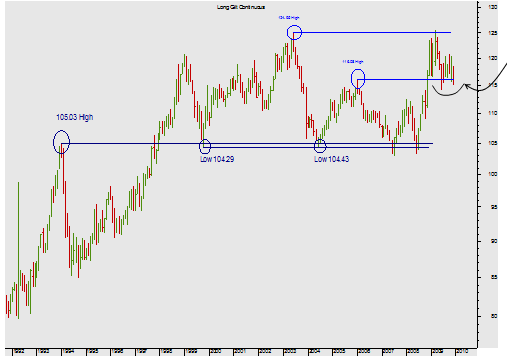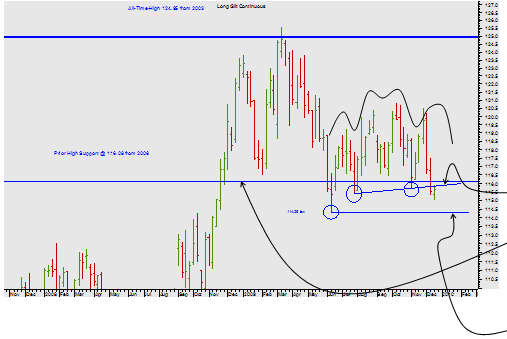UK Government Bonds, Gilts On Edge of Bear Market Triggers
Interest-Rates / UK Debt Dec 18, 2009 - 03:14 AM GMTBy: Seven_Days_Ahead
 The Technical Trader’s view:
The Technical Trader’s view:
 |
MONTHLY CHART
|
|
DAILY CHART And the detail of the consolidation suggests a possible complex Head and Shoulders top formation close to completion. Watch for a second close beneath that neckline currently at 115.86 A confirmed completion of that H&S pattern would signal a break of the long-term horizontal support at 116.08. A second bear short-term bear trigger to watch would be a breakdown beneath the Prior Low at 114.26. |
The Macro Trader’s view:
The Gilt remains in a trading range that has dominated the market since June of this year and may yet persist further. But in recent weeks the market has rejected an attempt to break through the highs and is now within striking distance of the lows. Has anything changed or is the market still basically directionless?
We judge the dynamics driving this market may have changed sufficiently for the Gilt to attempt a bearish breakout. The reasons are:
- The Government singularly failed to tackle in a convincing way the debt build up that has occurred as a result of the recession and fiscal stimulus deployed to contain it.
- The economy remains in recession. The 3rd quarter was flagged as the moment when growth resumed, it didn’t happen, now all eyes on 4th quarter GDP, but industrial production and manufacturing output has remained surprisingly week, and only today retail sales undershot consensus by a significant margin.
- The build up of debt needs financing and borrowing cost are set to hit £60.0B, the government has made little mention of this, but it is double the defence budget.
- The ratings agencies are hovering around the UK’s sovereign AAA rating; so far they have only made reference to what needs to be done, but the inference is that if nothing happens, the rating will be lost, resulting in yet higher interest payments.
So what has supported the gilt over the last few months? Clearly the recession itself offered support in the early stages, as it was judged prudent to use fiscal measures to prevent a financial market meltdown. With growth turning so weak the outlook for inflation relaxed so much that deflation was feared.
The authorities responded with a QE program, designed to support the government debt market and at the same time expand the money supply sufficiently to turn deflation back to mild inflation.
And that policy seems to have worked. CPI, the targeted measure stands at 1.9% against a target of 2.0%. Moreover the Bank of England has forecast it to spike higher over the short term before dropping back.
But over recent months, the Bank’s record on forecasting lower inflation hasn’t been too good. If the spike in inflation doesn’t fall as expected, the market will be exposed to true trader sentiment. The QE program is scheduled to end in February. Then, in an environment where debt is at record levels, inflation is proving problematic, the Pound is weak and growth is barely visible, who would want to buy the gilt?
The only visible support is an election is due in May/June next year. The opinion polls have long forecast a strong Conservative win, but the lead in the polls enjoyed by the opposition Conservative party over the ruling Labour party has started to narrow. Why does this matter?
Well put simply, the main parties have different approaches on how to reduce the deficit. The Conservatives want to slash public spending, which will allow the private sector room to flourish, the Labour government will raise tax, and that will restrict private enterprise, and condemn the economy to years of slow growth making the deficit more entrenched and harder to reduce.
The markets may have traded sideways recently due to expectations of a change of government and policy, but if the opinion poll lead narrows much further, traders could become aggressive sellers of the gilt, and after last week’s pre-budget report we think there are signs that might be starting to happen already.
Mark Sturdy
John Lewis
Seven Days Ahead
Be sure to sign up for and receive these articles automatically at Market Updates
Mark Sturdy, John Lewis & Philip Allwright, write exclusively for Seven Days Ahead a regulated financial advisor selling professional-level technical and macro analysis and high-performing trade recommendations with detailed risk control for banks, hedge funds, and expert private investors around the world. Check out our subscriptions.
© 2009 Copyright Seven Days Ahead - All Rights Reserved
Disclaimer: The above is a matter of opinion provided for general information purposes only and is not intended as investment advice. Information and analysis above are derived from sources and utilising methods believed to be reliable, but we cannot accept responsibility for any losses you may incur as a result of this analysis. Individuals should consult with their personal financial advisors.
Seven Days Ahead Archive |
© 2005-2022 http://www.MarketOracle.co.uk - The Market Oracle is a FREE Daily Financial Markets Analysis & Forecasting online publication.




